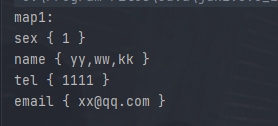
List<String> strings = Lists.newArrayList("name=kk", "sex=1", "tel=1111", "email=xx@qq.com","name=ww","name=yy");
一. 冷静分析
如上代码,你现在要做一个分组的Map将上面list的值读取出来,然后分组统计类似于Map<String,List< String >> 将Key相同的Val全部存到一个list里面
二. 直接开装
不会真有人还直接遍历吧,那别人不就看的懂了~ 为了炫技直接装一波
定义封装对象
@Data
@Builder
static class ObiectMap{
private String key;
private String value;
}
2.1 初级炫
System.out.println("map1: ");
Map<String, List<String>> collect1 = strings.stream().map(e -> { //封装成对象
String[] split = e.split("\\=", 2);
return ObiectMap.builder().key(split[0]).value(split[1]).build();
}).collect(Collectors.toMap(ObiectMap::getKey,v->Lists.newArrayList(v.getValue()), (List<String> newList, List<String> oldList) -> { // Collectors.toMap(a,b,(n1,n2)) -> a代表Map的key (这里直接用方法引用拿到key) b代表value (n1,n2)代表key相同时value的处理办法,直接合并List
oldList.addAll(newList);
return oldList;
}));
collect1.forEach((k,v)->{
System.out.printf(k+" { ");
String vList = v.stream().collect(Collectors.joining(",")); //加上逗号,最后一个不加
System.out.printf(vList);
System.out.printf(" }");
System.out.println();
});
System.out.println();
结果如下

2.2 普通炫
System.out.println("map2: ");
Map<String, List<String>> collect2 = strings.stream().map(e -> {
String[] split = e.split("\\=", 2);
return ObiectMap.builder().key(split[0]).value(split[1]).build();
}).collect(Collectors.groupingBy(ObiectMap::getKey, Collectors.mapping(ObiectMap::getValue, Collectors.toList()))); //Collectors.groupingBy(a,b) a还是通过key来分组 ,b将value收集起来做list value
collect2.forEach((k,v)->{
System.out.printf(k+" { ");
String vList = v.stream().collect(Collectors.joining(",")); //加上逗号,最后一个不加
System.out.printf(vList);
System.out.printf(" }");
System.out.println();
});
System.out.println();
结果如下

2.3 高级炫
用Guava来炫
import com.google.common.collect.*
System.out.println("map3: get name List with Multimap");
List<ObiectMap> collect3 = strings.stream().map(e -> {
String[] split = e.split("\\=", 2);
return ObiectMap.builder().key(split[0]).value(split[1]).build();
}).collect(Collectors.toList());
Multimap<String, String> multiMap = ArrayListMultimap.create(); //使用Guava的Multimap来存 value直接是collection,可以随意转换
collect3.forEach(c -> multiMap.put(c.getKey(), c.getValue()));
System.out.println(multiMap.get("name").stream().collect(Collectors.joining(",")));
System.out.println();
结果如下

2.4 再炫一波 拿到当前key与对应的数量
System.out.println("map4: get name with count");
Map<String, Long> collect4 = strings.stream().map(e -> {
String[] split = e.split("\\=", 2);
return ObiectMap.builder().key(split[0]).value(split[1]).build();
}).collect(Collectors.groupingBy(ObiectMap::getKey, Collectors.counting())); // 拿到数量
collect4.forEach((k,v)->{
System.out.printf(k+" { ");
System.out.printf("%d",v);
System.out.printf(" }");
System.out.println();
});
System.out.println();
结果如下

2.5 Map Reduce炫
这个不能处理重复value,只是将单一Map聚合到一个Map
List<String> strings = Lists.newArrayList("name=kk", "sex=1", "tel=1111", "email=xx@qq.com");
Map<String, String> reduce = strings.stream().map(e -> {
String[] split = e.split("\\=", 2); // 正则划分为单map
return Collections.singletonMap(split[0], split[1]);
}).reduce(new HashMap<String, String>(), (accMap, singleMap) -> { // reduce(a,(b,c))-> a 为初始值 b为累加值 c为当前值 操作返回当前值与累加值后的结果 将多个单KV的Map组合成一个Map
accMap.putAll(singleMap);
return accMap;
});
reduce.forEach((k,v)->{
System.out.println(k+" = "+v);
});

好家伙直接装一波,直接起飞~ 制作不易,转载请标注
到此这篇关于如何用Java Stream写出既高雅又装*的代码的文章就介绍到这了,更多相关Java Stream内容请搜索自学编程网以前的文章或继续浏览下面的相关文章希望大家以后多多支持自学编程网!

- 本文固定链接: https://zxbcw.cn/post/220267/
- 转载请注明:必须在正文中标注并保留原文链接
- QQ群: PHP高手阵营官方总群(344148542)
- QQ群: Yii2.0开发(304864863)
